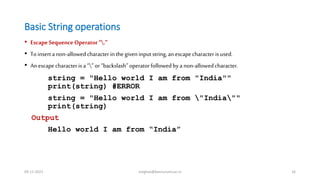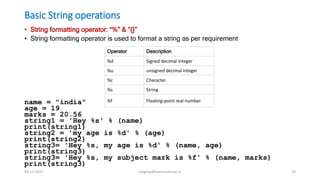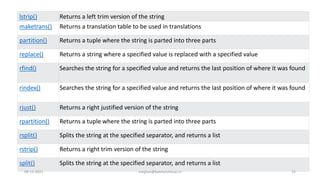Python programming: Anonymous functions, String operations
- 1. Python Programming Part V Megha V Research Scholar Kannur University 09-11-2021 [email protected] 1
- 2. Anonymous Functions • Anonymous function is a function that is defined without a name. • Anonymous function is defined using the lambda keyword • Also called lambda functions syntax lambda [,arg1 [,arg2,……….argn]]:expression Eg: # Lambda function definition square=lambda x : x*x; # Usage of lambda function n=int(input(“Enter a number:”)) print(“square of”,n,”is”,square(n)) # Output Enter a number:5 Square of 5 is 25 09-11-2021 [email protected] 2
- 3. Main characteristics of lambda function 1. Lambda functions can take any number of arguments but return only one value in the form of an expression 2. It cannot contain multiple expressions 3. It cannot have comments 4. A lambda function cannot be a direct call to print because lambda requires an expression 5. Lambda functions have their own local namespace and cannot access variables other than those in their parameter list and those in the global namespace 6. Lambda functions are not equivalent to inline functions in C or C++ 09-11-2021 [email protected] 3
- 4. • lambda is the keyword, x shows the argument passed, and x*x is the expression to be evaluated and stored in the variable square Example with two arguments # Lambda function definition sum =lambda x,y : x+y #usage of lambda function m=int(input(“Enter first number:”)) n=int(input(“Enter second number:”)) print(“sum of”,m,”and”,n,”is”,sum(m,n))#lambda function call 09-11-2021 [email protected] 4
- 5. Use of lambda function • We use lambda function when we require a nameless function for a short period of time. • Lambda functions are used along with built-in functions like filter(), map() etc • The map() function in Python takes input; function and a list. • The function is called with all the item in the list and a new list is returned which contains items returned by that function for each item 09-11-2021 [email protected] 5
- 6. #Lambda function to increment the items in list by 2 oldlist=[2,31,42,11,6,5,23,44] print(oldlist) #Usage of lambda function newlist=list(map(lambda x: x+2,oldlist)) print(“List after incrementation by 2”) print(newlist) Output [2,31,42,11,6,5,23,44] List after incrementation by 2 [4,33,44,13,8,7,25,46] lambda function 09-11-2021 [email protected] 6
- 7. • filter() function • The function filter(function,list) offers a way to filter out all the elements of a list, for which the function returns True. • The first argument function returns a Boolean value, i.e., either True or False. • This function will be applied to every element of the list lis. 09-11-2021 [email protected] 7
- 8. Example: The function called with all the items in the list and a new list is returned which contains items for which the function evaluates to True #Lambda function to filter out only odd numbers from a list oldlist=[2,31,42,11,6,5,23,44] newlist=list(filter(lambda x:(x%2!=0),oldlist)) print(oldlist) print(newlist) Output [2,31,42,11,6,5,23,44] [31,11,5,23] 09-11-2021 [email protected] 8
- 9. reduce() function • The function reduce(func,seq) continually applies the fuction func() to the sequence seq. • It returns a single value • If seq=[s1,s2, s3…………….sn], calling reduce(func,seq) work like this: • At first the two elements of seq will be applied to func, i.e func(s1,s2) • The list on which reduce() works looks now like this: [func(s1,s2),s3………sn] • In the next step func will be applied on the previous result and the third element of the list, i.e. func(func(s1,s2),s3) • The list looks like this now: [func(func(s1,s2),s3),………,sn] 09-11-2021 [email protected] 9
- 10. • Continue like this until just one element is left and return this element as the result of reduce() • Used for performing some computation on list and returning the result. • The following example illustrates the use of reduce() function, that computes the product of a list of integers • Example: import functools list=[1,2,3,4] product=functools.reduce[lambda x,y:x*y,list] print(list) print(“Product=” product) Output [1,2,3,4] product=24 09-11-2021 [email protected] 10
- 11. Function with more than one return type • Instead of writing separate functions for returning individual values, we can return all the values withing same function • Example: def cal(a,b) sum=a+b diff=a-b prod=a*b quotient=a/b return sum,diff,prod,quotient a=int(input(“Enter first number:”)) b=int(input(“Enter second number:”)) s,d,p,q=calc(a,b) print(“Sum=”,s) print(“Difference=”,d) print(“Product=”,p) print(“Quotient=”,q) Output Enter first number:10 Enter Second number:5 Sum=15 Difference=5 Product=50 Quotient=5 09-11-2021 [email protected] 11
- 12. Strings • Python allows several string operators that can be applied on the python string are as below: 1. Assignment operator: “=.” 2. Concatenate operator: “+.” 3. String repetition operator: “*.” 4. String slicing operator: “[]” 5. String comparison operator: “==” & “!=” 6. Membership operator: “in” & “not in” 7. Escape sequence operator: “.” 8. String formatting operator: “%” & “{}” 09-11-2021 [email protected] 12
- 13. Basic String operations • Assignment operator: “=.” string1 = "hello“ • Concatenate operator: “+.” string1 = "hello" string2 = "world " string_combined = string1+string2 print(string_combined) • String repetition operator: “*.” string1 = "helloworld " print(string1*2) 09-11-2021 [email protected] 13
- 14. Basic String operations string1 = "helloworld" print(string1[1]) print(string1[-3]) print(string1[1:5]) print(string1[1:-3]) print(string1[2:]) print(string1[:5]) print(string1[:-2]) print(string1[-2:]) print(string1[::-1]) • String slicing operator: “[]” 09-11-2021 [email protected] 14
- 15. Basic String operations String comparison operator: “==” & “!=” string1 = "hello" string2 = "hello, world" string3 = "hello, world" string4 = "world" print(string1==string4) #False print(string2==string3) #True print(string1!=string4) #True Membership operator: “in” & “not in” string1 = "helloworld" print("w" in string1) #True print("W" in string1) #False print("t" in string1) #False print("t" not in string1) #True print("hello" in string1) #True print("Hello" in string1) #False 09-11-2021 [email protected] 15
- 16. Basic String operations • EscapeSequence Operator“.” • To inserta non-allowedcharacterin thegiveninput string,an escapecharacterisused. • An escapecharacterisa “” or “backslash”operatorfollowedby a non-allowedcharacter. string = "Hello world I am from "India"" print(string) #ERROR string = "Hello world I am from "India"" print(string) Output Hello world I am from “India” 09-11-2021 [email protected] 16
- 17. • Escape characters • An escape character is a character that gets interpreted when placed in single or double quotes Escape character Description a Bell or alert b Backspace f Formfeed n Newline r Carriage return s Space t Tab v Vertical Tab 09-11-2021 [email protected] 17
- 18. Basic String operations • String formatting operator: “%” & “{}” • String formatting operator is used to format a string as per requirement name = "india" age = 19 marks = 20.56 string1 = 'Hey %s' % (name) print(string1) string2 = 'my age is %d' % (age) print(string2) string3= 'Hey %s, my age is %d' % (name, age) print(string3) string3= 'Hey %s, my subject mark is %f' % (name, marks) print(string3) Operator Description %d Signed decimal integer %u unsigned decimal integer %c Character %s String %f Floating-point real number 09-11-2021 [email protected] 18
- 19. Strings • Python has a set of built-in methods that you can use on strings. Method Description capitalize() Converts the first character to upper case casefold() Converts string into lower case center() Returns a centered string count() Returns the number of times a specified value occurs in a string encode() Returns an encoded version of the string endswith() Returns true if the string ends with the specified value expandtabs() Sets the tab size of the string find() Searches the string for a specified value and returns the position of where it was found format() Formats specified values in a string format_map() Formats specified values in a string index() Searches the string for a specified value and returns the position of where it was found isalnum() Returns True if all characters in the string are alphanumeric isalpha() Returns True if all characters in the string are in the alphabet isascii() Returns True if all characters in the string are ascii characters 09-11-2021 [email protected] 19
- 20. isdecimal() Returns True if all characters in the string are decimals isdigit() Returns True if all characters in the string are digits isidentifier() Returns True if the string is an identifier islower() Returns True if all characters in the string are lower case isnumeric() Returns True if all characters in the string are numeric isprintable() Returns True if all characters in the string are printable isspace() Returns True if all characters in the string are whitespaces istitle() Returns True if the string follows the rules of a title isupper() Returns True if all characters in the string are upper case join() Converts the elements of an iterable into a string ljust() Returns a left justified version of the string lower() Converts a string into lower case 09-11-2021 [email protected] 20
- 21. lstrip() Returns a left trim version of the string maketrans() Returns a translation table to be used in translations partition() Returns a tuple where the string is parted into three parts replace() Returns a string where a specified value is replaced with a specified value rfind() Searches the string for a specified value and returns the last position of where it was found rindex() Searches the string for a specified value and returns the last position of where it was found rjust() Returns a right justified version of the string rpartition() Returns a tuple where the string is parted into three parts rsplit() Splits the string at the specified separator, and returns a list rstrip() Returns a right trim version of the string split() Splits the string at the specified separator, and returns a list 09-11-2021 [email protected] 21
- 22. splitlines() Splits the string at line breaks and returns a list startswith() Returns true if the string starts with the specified value strip() Returns a trimmed version of the string swapcase() Swaps cases, lower case becomes upper case and vice versa title() Converts the first character of each word to upper case translate() Returns a translated string upper() Converts a string into upper case zfill() Fills the string with a specified number of 0 values at the beginning 09-11-2021 [email protected] 22
- 23. Example s=‘Learning Python is easy’ print(s.lower()) print(s.title()) print(s.upper()) print(s.swapcase()) print(s.capitalize()) 09-11-2021 [email protected] 23

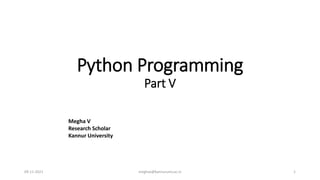
![Anonymous Functions
• Anonymous function is a function that is defined without a name.
• Anonymous function is defined using the lambda keyword
• Also called lambda functions
syntax
lambda [,arg1 [,arg2,……….argn]]:expression
Eg: # Lambda function definition
square=lambda x : x*x;
# Usage of lambda function
n=int(input(“Enter a number:”))
print(“square of”,n,”is”,square(n)) #
Output
Enter a number:5
Square of 5 is 25
09-11-2021 meghav@kannuruniv.ac.in 2](https://image.slidesharecdn.com/pythonprogramming5-211109085347/85/Python-programming-Anonymous-functions-String-operations-2-320.jpg)


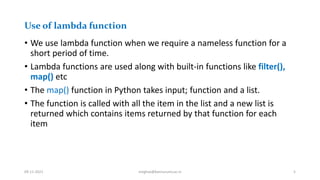
![#Lambda function to increment the items in list by 2
oldlist=[2,31,42,11,6,5,23,44]
print(oldlist)
#Usage of lambda function
newlist=list(map(lambda x: x+2,oldlist))
print(“List after incrementation by 2”)
print(newlist)
Output
[2,31,42,11,6,5,23,44]
List after incrementation by 2
[4,33,44,13,8,7,25,46]
lambda function
09-11-2021 meghav@kannuruniv.ac.in 6](https://image.slidesharecdn.com/pythonprogramming5-211109085347/85/Python-programming-Anonymous-functions-String-operations-6-320.jpg)

![Example: The function called with all the items in the list and a new list is returned
which contains items for which the function evaluates to True
#Lambda function to filter out only odd numbers from a
list
oldlist=[2,31,42,11,6,5,23,44]
newlist=list(filter(lambda x:(x%2!=0),oldlist))
print(oldlist)
print(newlist)
Output
[2,31,42,11,6,5,23,44]
[31,11,5,23]
09-11-2021 meghav@kannuruniv.ac.in 8](https://image.slidesharecdn.com/pythonprogramming5-211109085347/85/Python-programming-Anonymous-functions-String-operations-8-320.jpg)
![reduce() function
• The function reduce(func,seq) continually applies the fuction func() to the
sequence seq.
• It returns a single value
• If seq=[s1,s2, s3…………….sn], calling reduce(func,seq) work like this:
• At first the two elements of seq will be applied to func, i.e func(s1,s2)
• The list on which reduce() works looks now like this: [func(s1,s2),s3………sn]
• In the next step func will be applied on the previous result and the third
element of the list, i.e. func(func(s1,s2),s3)
• The list looks like this now: [func(func(s1,s2),s3),………,sn]
09-11-2021 meghav@kannuruniv.ac.in 9](https://image.slidesharecdn.com/pythonprogramming5-211109085347/85/Python-programming-Anonymous-functions-String-operations-9-320.jpg)
![• Continue like this until just one element is left and return this element as the
result of reduce()
• Used for performing some computation on list and returning the result.
• The following example illustrates the use of reduce() function, that computes
the product of a list of integers
• Example:
import functools
list=[1,2,3,4]
product=functools.reduce[lambda x,y:x*y,list]
print(list)
print(“Product=” product)
Output
[1,2,3,4]
product=24
09-11-2021 meghav@kannuruniv.ac.in 10](https://image.slidesharecdn.com/pythonprogramming5-211109085347/85/Python-programming-Anonymous-functions-String-operations-10-320.jpg)

![Strings
• Python allows several string operators that can be applied on the python
string are as below:
1. Assignment operator: “=.”
2. Concatenate operator: “+.”
3. String repetition operator: “*.”
4. String slicing operator: “[]”
5. String comparison operator: “==” & “!=”
6. Membership operator: “in” & “not in”
7. Escape sequence operator: “.”
8. String formatting operator: “%” & “{}”
09-11-2021 meghav@kannuruniv.ac.in 12](https://image.slidesharecdn.com/pythonprogramming5-211109085347/85/Python-programming-Anonymous-functions-String-operations-12-320.jpg)

![Basic String operations
string1 = "helloworld"
print(string1[1])
print(string1[-3])
print(string1[1:5])
print(string1[1:-3])
print(string1[2:])
print(string1[:5])
print(string1[:-2])
print(string1[-2:])
print(string1[::-1])
• String slicing operator: “[]”
09-11-2021 meghav@kannuruniv.ac.in 14](https://image.slidesharecdn.com/pythonprogramming5-211109085347/85/Python-programming-Anonymous-functions-String-operations-14-320.jpg)

